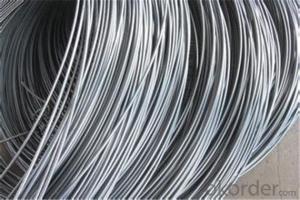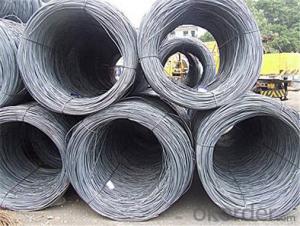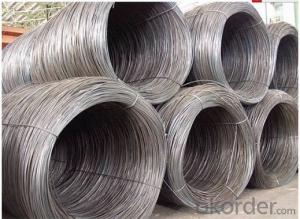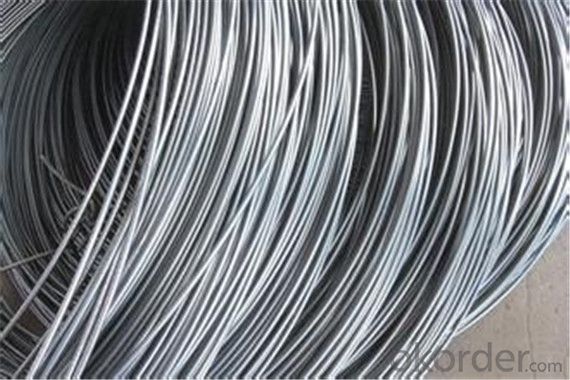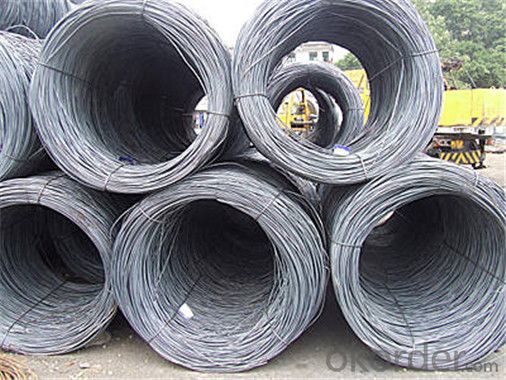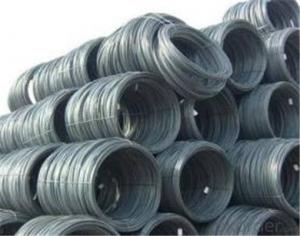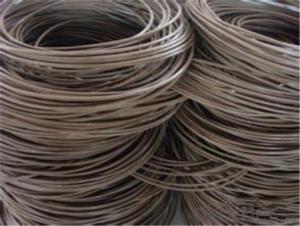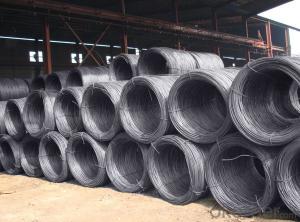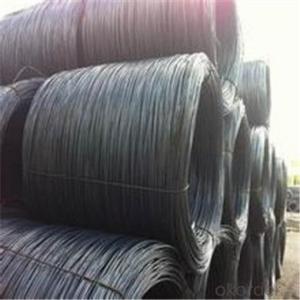SAE1006 Hot Rolled Steel Wire Rod 6.5mm with in China
- Loading Port:
- Shanghai
- Payment Terms:
- TT OR LC
- Min Order Qty:
- 500 m.t.
- Supply Capability:
- 45555555 m.t./month
OKorder Service Pledge
OKorder Financial Service
You Might Also Like
Specification
Description of wire Rod:
Our company is recognized by ISO9001:2008
1. hot rolled wire rod
2. material: Q195-235
Festures of wire Rod:
1. Drawn wire specialist, your wire rod solution
2. ISO9001 Certified Mill &SGS
3. Feature: machinability, high hardness, toughness, corrosion resistant
Specifications of wire Rod:
Product | steel wire rod |
Standard | AISI, ASTM, BS, DIN, GB, JIS |
Material/steel grade | Q195-Q235,SAE1006, SAE1008, SAE1010, SAE1018, SAE1020 or according to customers requirements |
Wire Gauge | 5.5-12mm |
Coil weight | 1.8-2.1mts |
MOQ | 25MT |
Delivery Time | 15-30 days after receipt of L/C or deposit by T/T |
Packing | In coil and load in container, if large quantity, by bulk vessel; Can be packed as customers' special requirements |
Payment terms | 1).100% irrevocable L/C at sight. |
Application | widely used in machinery parts |
Images of wire Rod:
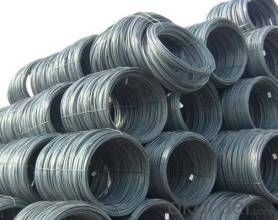
FAQ:
1. What is your package?
Packing situation: standard seaworthy packing or as customer required.
2. How long is the lead time?
Delivery time: 45 days after order confirmed.
- Q: What are the advantages of using steel wire rod in mining applications?
- There are several advantages of using steel wire rod in mining applications. Firstly, steel wire rod is known for its high strength and durability, making it capable of withstanding the harsh conditions and heavy loads typically found in mining operations. Its strength also allows for the construction of sturdy support structures, ensuring the safety of workers and the stability of mining tunnels. Additionally, steel wire rod has excellent resistance to corrosion, which is crucial in the presence of water and other corrosive substances commonly encountered in mining environments. Furthermore, steel wire rod can be easily manipulated and shaped, allowing for customization to meet specific mining requirements. Overall, the advantages of using steel wire rod in mining applications include its strength, durability, corrosion resistance, and versatility.
- Q: What are the common welding techniques used for steel wire rod?
- The common welding techniques used for steel wire rod include gas metal arc welding (GMAW), shielded metal arc welding (SMAW), and resistance welding.
- Q: What are the main factors affecting the market expansion of steel wire rod?
- The main factors affecting the market expansion of steel wire rod include demand from various industries such as automotive, construction, and infrastructure, as well as economic growth and industrialization in emerging markets. Additionally, factors such as government policies, technological advancements, and competitive pricing also play a significant role in driving the market expansion of steel wire rod.
- Q: What are the main factors affecting the market share of steel wire rod?
- The main factors affecting the market share of steel wire rod include the overall demand for steel products, competition from alternative materials, pricing and cost factors, technological advancements, and the influence of government policies and regulations. Additionally, customer preferences, industry trends, and the global economic environment also play a significant role in shaping the market share of steel wire rod.
- Q: What are the main factors affecting the product competitiveness of steel wire rod?
- The main factors affecting the product competitiveness of steel wire rod include the quality and consistency of the product, pricing competitiveness, delivery reliability, customer service, technical support, and the ability to meet specific customer requirements. Additionally, factors such as the reputation and brand image of the manufacturer, market demand and trends, competition from other suppliers, and the cost and availability of raw materials also play a significant role in determining the product's competitiveness.
- Q: How is steel wire rod used in the manufacturing of wire mesh for filtration?
- Steel wire rod is a crucial component in the manufacturing of wire mesh for filtration as it serves as the raw material for the mesh. The steel wire rod is drawn and stretched to the desired thickness and diameter, and then woven or welded to create the mesh structure. This allows for the precise filtration of particles or fluids, making it an essential material in various industries such as automotive, mining, and food processing.
- Q: What are the different alloys used in steel wire rod production?
- There are several different alloys used in steel wire rod production, including carbon steel, stainless steel, and alloy steel. Carbon steel is the most commonly used alloy and is known for its strength and durability. Stainless steel wire rods are highly corrosion-resistant and often used in applications where corrosion is a concern, such as in marine environments. Alloy steel wire rods are made by adding different alloying elements, such as chromium, nickel, or molybdenum, which enhance the mechanical properties of the wire rod, such as hardness, toughness, and heat resistance.
- Q: How is steel wire rod used in the manufacturing of wire mesh baskets?
- Steel wire rod is used in the manufacturing of wire mesh baskets as it serves as the primary material for creating the wires that form the mesh. The steel wire rod is first drawn through a series of dies to reduce its diameter and increase its length. These elongated wires are then welded or woven together to form the mesh structure of the baskets. The strength and durability of the steel wire rod make it an ideal choice for withstanding heavy loads, ensuring the stability and longevity of the wire mesh baskets.
- Q: How is the price of recycled steel wire rod determined?
- The price of recycled steel wire rod is determined by several factors. Firstly, the demand and supply dynamics play a crucial role in determining the price. If there is a high demand for recycled steel wire rod in the market, coupled with a limited supply, the price is likely to increase. Conversely, if the supply exceeds the demand, the price may decrease. Secondly, the quality and grade of the recycled steel wire rod are important factors in price determination. Higher quality rods that meet industry standards and specifications generally command a higher price compared to lower-grade or substandard rods. Additionally, the cost of production and processing also affects the price. Factors such as the cost of collecting and sorting scrap metal, transportation, energy, labor, and other operational expenses are considered in determining the final price of recycled steel wire rod. Furthermore, market conditions and fluctuations in the prices of raw materials and other related commodities can impact the price of recycled steel wire rod. For example, if the price of iron ore (a key raw material in steel production) increases, it can lead to higher production costs, which may be reflected in the price of recycled steel wire rod. Lastly, external factors such as government regulations, trade policies, and environmental considerations can influence the price of recycled steel wire rod. For instance, if there are stricter regulations on carbon emissions or waste management, it may increase the cost of production and subsequently impact the price. In summary, the price of recycled steel wire rod is determined by the demand and supply dynamics, quality and grade, production costs, market conditions, and external factors. Analyzing these factors is essential for understanding and predicting the fluctuations in the price of recycled steel wire rod.
- Q: How does the recycling process affect the mechanical properties of steel wire rod?
- The recycling process of steel wire rod can have both positive and negative effects on its mechanical properties. One of the main advantages of recycling steel wire rod is that it helps conserve natural resources and reduce the overall carbon footprint of the steel industry. By using scrap steel as a raw material, the recycling process can save energy and reduce emissions associated with mining and processing iron ore. This conservation of resources and reduction in energy consumption can indirectly contribute to the mechanical properties of the recycled steel wire rod. However, the recycling process can also introduce impurities and alloying elements that may affect the mechanical properties of the steel wire rod. During the melting and refining stages of the recycling process, impurities such as sulfur, phosphorous, and non-metallic inclusions can be introduced into the steel composition. These impurities can have adverse effects on the mechanical properties, such as reducing ductility, toughness, and fatigue strength. In addition, the recycling process may also lead to changes in the microstructure of the steel wire rod. The repeated heating and cooling cycles during melting, casting, and rolling can alter the grain size, grain boundaries, and phase distribution within the steel. These changes can impact the mechanical properties of the steel wire rod, such as its hardness, tensile strength, and elongation. To mitigate the potential negative effects of the recycling process on the mechanical properties of steel wire rod, various techniques and processes can be implemented. For instance, advanced refining methods can be employed to reduce impurities and control the chemical composition of the recycled steel. Additionally, heat treatment processes can be used to optimize the microstructure and improve the mechanical properties of the steel wire rod. Overall, while the recycling process of steel wire rod has the potential to impact its mechanical properties, with proper quality control measures and optimization techniques, the recycled steel can still meet the required mechanical specifications for various applications.
Send your message to us
SAE1006 Hot Rolled Steel Wire Rod 6.5mm with in China
- Loading Port:
- Shanghai
- Payment Terms:
- TT OR LC
- Min Order Qty:
- 500 m.t.
- Supply Capability:
- 45555555 m.t./month
OKorder Service Pledge
OKorder Financial Service
Similar products
Hot products
Hot Searches
Related keywords
